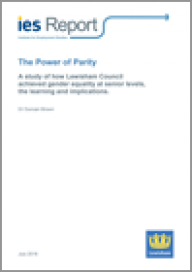Publications
 We author and publish a range of resources to keep you up to date with the latest developments in employment, labour market and human resource policy and practice.
We author and publish a range of resources to keep you up to date with the latest developments in employment, labour market and human resource policy and practice.
All our pdf publications are free to access.
Search results
-

Precarious Employment in Europe: Country Case Studies
Broughton A, Green M, Rickard C, Swift S, Eichhorst W, Tobsch V, Magda I, Lewandowski P, Keister R, Jonaviciene D, Ramos Martin N E, Valsamis D, Tros F | Jul 2016 | European ParliamentThis report contains the results of eight country cases studies for Denmark, France, Germany, Lithuania, Netherlands, Poland, Spain, and the United Kingdom reviewing precarious employment. The case studies examine three types of employment in each country that were deemed to be at a relatively high risk of precariousness.
-

Precarious Employment in Europe: Patterns, Trends and Policy Strategies
Broughton A, Green M, Rickard C, Swift S, Eichhorst W, Tobsch V, Magda I, Lewandowski P, Keister R, Jonaviciene D, Ramos Martin N E, Valsamis D, Tros F | Jul 2016 | European ParliamentThis study examines precarious employment, its patterns, trends and policy strategies in Europe. It explores the risk of precariousness of different types of contract, using information from EU data analysis and a literature review, as well as case studies of eight EU Member States. It finds that there are a range and degrees of risks of precariousness associated with all types of contract, based on key indicators of precariousness.
-
📄
Podcast: Gender pay gap reporting: full analysis and insight
Brown D | Jul 2016 | Institute for Employment StudiesDuncan Brown's debrief podcast for IES HR Network event 'Gender pay gap reporting: full analysis and insight'.
-

Slides: Closing the gender pay gap in higher education: A sector-wide approach
Hopkins L | Jul 2016 | Institute for Employment StudiesLaurence Hopkins' presentation slides from IES HR Network event 'Gender pay gap reporting: full analysis and insight', 21 July 2016
-

Slides: Gender pay as part of a diversity strategy
Gaynor K | Jul 2016 | Institute for Employment StudiesKaren Gaynor's presentation slides from IES HR Network event 'Gender pay gap reporting: full analysis and insight', 21 July 2016
-

Slides: Gender pay reporting: Overview
Williams A | Jul 2016 | Institute for Employment StudiesAudrey Williams' slides from IES HR Network event 'Gender pay gap reporting: full analysis and insight', 21 July 2016
-

Slides: Gender pay gap reporting: Important, undesireable or irrelevant
Brown D | Jul 2016 | Institute for Employment StudiesDuncan Brown's presentation slides from IES HR Network event 'Gender pay gap reporting: full analysis and insight', 21 July 2016.
-

The Power of Parity
A study of how Lewisham Council achieved gender equality at senior levels, the learning and implications
Brown D | Jul 2016 | Institute for Employment StudiesWith a near-equal gender mix at the top of their organisation, Lewisham Council have successfully overcome the continuing gender pay and position inequality that still persists in many organisations across the UK. A new IES report investigates how Lewisham, with 56 per cent of those in senior grades female and a pay gap slightly in favour of women, have achieved this.
-

Final Evaluation of the ReAct programme 2008-2014: Final Report Summary
Jul 2016 | Welsh GovernmentThis report summary, containing IES research, offers an overview of the evaluation of the ReAct programme. The Redundancy Action Scheme (ReAct) aims to prevent long-term unemployment by providing pathways to employment for those recently or about to become unemployed.
-

Final evaluation of the ReAct programme 2008-2014: Final report
Jul 2016 | Welsh GovernmentThis report, containing IES research, evaluates the Redundancy Action Scheme (ReAct). The scheme aims to prevent long-term unemployment by providing pathways to employment for those recently or about to become unemployed. IES contributed quantitative data analysis to the research.
